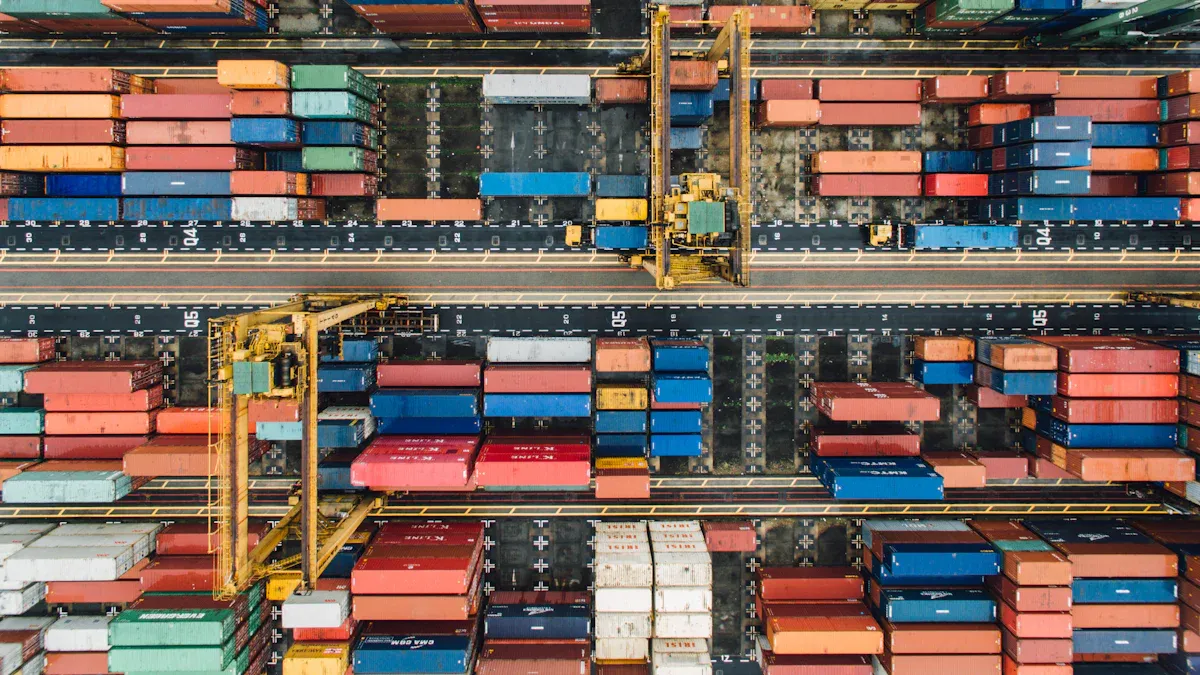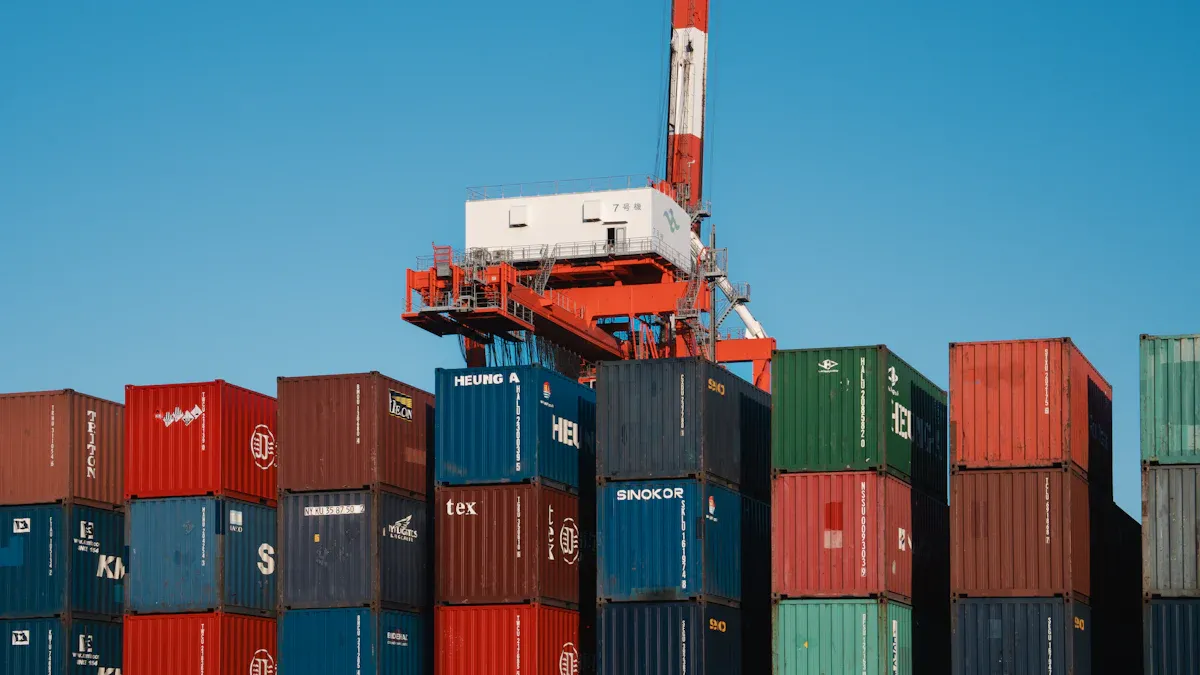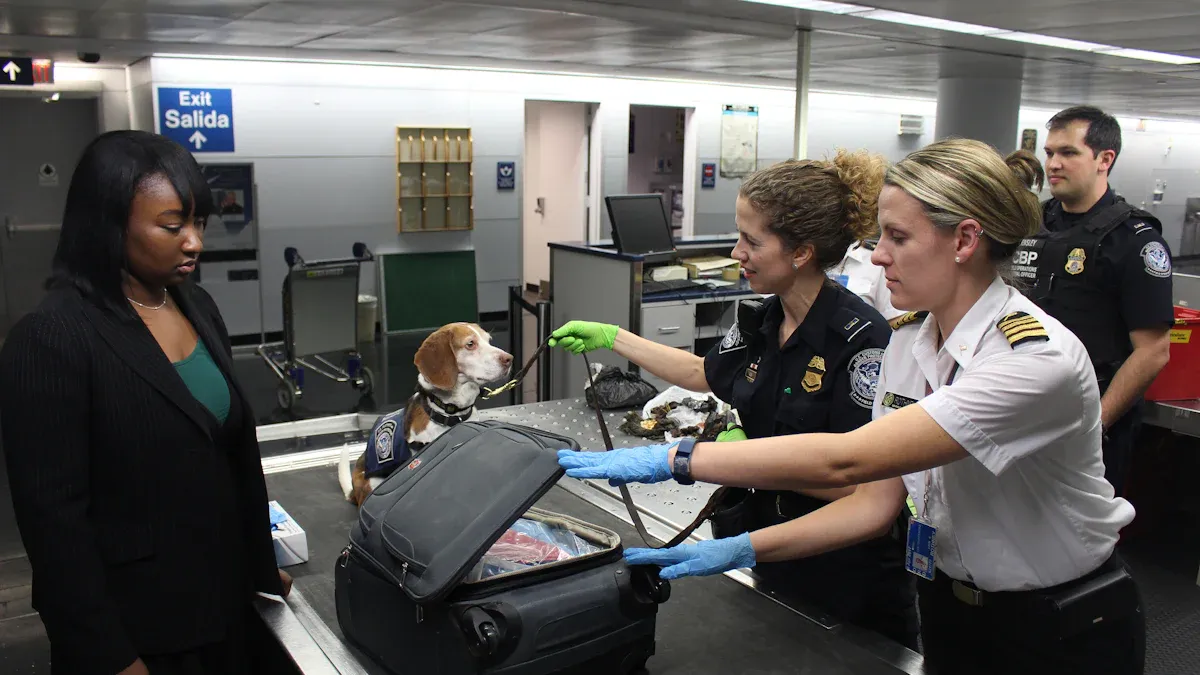What is Customs Clearance and Why It Matters in Trade

Customs clearance ensures your goods meet all legal and regulatory requirements for international trade. This process plays a vital role in keeping shipments moving smoothly across borders. Without proper clearance, delays can lead to costly setbacks, such as demurrage charges or detention fees. These disruptions may also harm your business by increasing shipping costs, delaying production schedules, or even damaging customer relationships. By prioritizing efficient customs clearance, you can avoid such risks and maintain the seamless flow of goods in global trade.
Key Takeaways
Customs clearance is important to follow trade laws. It helps businesses avoid fines and problems by making sure shipments follow rules.
Quick customs processes save time and money. Faster clearance can cut delays by 30%, helping goods arrive sooner and keeping customers happy.
Correct paperwork is key for easy customs clearance. Accurate invoices, packing lists, and shipping papers stop delays and extra fees.
Using customs brokers makes the process easier. Their knowledge of rules and forms helps businesses avoid mistakes and confusion.
Using technology improves customs work. Automation lowers mistakes and speeds up tasks, helping businesses compete better in global trade.
Key Components of the Customs Clearance Process

Pre-Clearance Preparation
Pre-clearance preparation lays the foundation for a smooth customs clearance process. This step involves gathering and organizing all necessary documents, ensuring compliance with regulations, and verifying shipment details. You must prepare documents like the commercial invoice, packing list, and certificates of origin. These papers provide customs authorities with the information they need to assess your shipment.
Proper pre-clearance preparation also includes checking the accuracy of product classifications and tariff codes. Misclassification can lead to delays or penalties. You should confirm that your goods meet the import or export requirements of the destination country. For example, some countries require specific permits for restricted items like chemicals or electronics.
To streamline this step, many businesses rely on customs brokers or freight forwarders. These professionals help you navigate complex regulations and ensure your paperwork is complete. By investing time in pre-clearance preparation, you reduce the risk of errors and avoid unnecessary delays.
Customs Inspection and Assessment
Once your shipment reaches customs, it undergoes inspection and assessment. Customs officials review your documentation and may physically inspect the goods to verify compliance. This step ensures that your shipment aligns with the declared information and meets safety and regulatory standards.
Inspections can vary in scope. Some shipments only require a visual check, while others undergo detailed assessments. The table below highlights key components of the inspection process:
Component | Description |
|---|---|
Visual Inspection | Checking for visible defects, damages, and contamination. |
Verification of Product Specs | Ensuring product dimensions, materials, and compliance with industry standards. |
Functional Testing | Testing product functionality, performance metrics, and safety compliance. |
Packaging and Labeling Checks | Verifying packaging standards and regulatory compliance for labels. |
Documentation Review | Ensuring all necessary paperwork is complete and accurate for customs clearance. |
Customs officials may also assess the value of your goods to calculate duties and taxes. Providing accurate documentation minimizes the likelihood of disputes or additional inspections. If your shipment passes this stage, it moves closer to final clearance.
Payment of Duties and Taxes
Paying duties and taxes is a crucial step in the customs clearance process. These fees depend on factors like the type of goods, their value, and the destination country's tariff rates. You must ensure that all payments are made promptly to avoid delays in releasing your shipment.
Customs authorities calculate duties based on the declared value of your goods. They may also apply additional taxes, such as value-added tax (VAT) or excise duties, depending on the product category. For example, luxury items often incur higher taxes than essential goods.
To simplify this process, you can use online payment systems or work with customs brokers. These professionals can help you understand the applicable fees and ensure accurate payment. Once you settle all duties and taxes, customs authorities issue a release order, allowing your goods to proceed to their final destination.
Tip: Always double-check your payment receipts and keep records for future reference. This practice helps you resolve any disputes quickly and ensures compliance with customs regulations.
Final Release of Goods
The final release of goods marks the conclusion of the customs clearance process. At this stage, customs authorities grant permission for your shipment to leave their control and proceed to its destination. This step ensures that all legal, regulatory, and financial obligations have been met.
To achieve the final release, you must provide proof that all duties and taxes have been paid. Customs officials will also verify that your shipment has passed any required inspections. Once these conditions are satisfied, they issue a release order. This document acts as the green light for your goods to move forward.
Here’s what happens during the final release:
Verification of Compliance: Customs officials confirm that your shipment complies with all regulations. They check that the declared information matches the actual goods.
Issuance of Release Order: After verifying compliance, customs authorities issue a release order. This document allows your shipment to exit customs control.
Handover to Carrier: Once released, your goods are handed over to the carrier or freight forwarder. They then transport the shipment to its final destination.
Tip: Keep a copy of the release order and other customs documents for your records. These can be useful for audits or resolving disputes.
The final release is a critical milestone in the shipping process. It ensures that your goods can reach their destination without further delays. By staying organized and proactive, you can make this step as smooth as possible.
Importance of Customs Clearance in Trade
Ensuring Legal Compliance
Customs clearance ensures your business follows all trade laws and regulations. By complying with these rules, you avoid penalties and legal disputes. For example, customs authorities require accurate documentation to verify shipments. Properly classified goods and timely payment of duties demonstrate your commitment to compliance. This protects your business from fines and ensures smooth operations.
Efficient customs clearance also safeguards your reputation. When you follow the rules, you build trust with customs officials and trading partners. This trust can lead to faster processing times and fewer inspections in the future.
Note: Understanding customs laws helps you avoid penalties. Non-compliance often results in fines or even the seizure of goods, which can disrupt your supply chain.
Facilitating Smooth Trade Operations
Customs clearance plays a vital role in keeping your shipments on schedule. When you prepare accurate documents and meet all requirements, your goods move through borders without unnecessary delays. This efficiency helps you maintain production timelines and meet customer expectations.
Smooth customs processes also reduce costs. Delays at customs can lead to storage fees or missed delivery deadlines. By prioritizing compliance, you minimize these risks and keep your operations running efficiently.
Tip: Collaborating with customs brokers can simplify the process. These experts handle documentation and ensure your shipments meet all regulatory standards.
Avoiding Delays and Penalties
Delays and penalties can harm your business. Incomplete or incorrect documentation often causes shipments to be held at customs. This not only disrupts your supply chain but also increases costs. For instance, detention fees or fines for non-compliance can quickly add up.
Efficient customs clearance prevents these issues. By adhering to regulations and paying duties on time, you avoid legal complications. Proper documentation also reduces the risk of goods being seized or delayed.
Businesses that comply with customs laws face fewer penalties.
Timely payment of duties ensures shipments are released without delays.
Accurate paperwork minimizes the risk of additional inspections or fines.
By focusing on customs clearance, you protect your business from unnecessary setbacks. This allows you to deliver goods on time and maintain strong relationships with customers.
Roles and Responsibilities in Customs Clearance
Customs Brokers
Customs brokers act as your trusted guides through the customs clearance process. They specialize in handling the complex paperwork and regulations required for international trade. By working with a customs broker, you gain access to their expertise in tariff classifications, duty calculations, and compliance requirements.
Here’s how customs brokers help you:
Documentation Management: They prepare and submit essential documents, such as commercial invoices and customs declarations.
Regulatory Compliance: Brokers ensure your shipments meet all legal requirements, reducing the risk of fines or delays.
Communication: They liaise with customs authorities on your behalf, addressing any issues that arise during inspections.
Tip: Partnering with a licensed customs broker can save you time and prevent costly mistakes. Their knowledge of local regulations ensures your goods clear customs smoothly.
Freight Forwarders
Freight forwarders play a key role in coordinating the transportation of your goods. They manage logistics and ensure your shipments reach their destination efficiently. While they don’t handle customs clearance directly, they work closely with customs brokers to streamline the process.
Freight forwarders assist you in several ways:
Shipment Planning: They organize routes, carriers, and schedules to optimize delivery times.
Documentation Support: Forwarders provide accurate shipping documents, such as bills of lading, to facilitate customs clearance.
Problem Solving: They address logistical challenges, such as delays or rerouting, to keep your supply chain on track.
Note: Freight forwarders simplify international shipping by managing logistics and collaborating with customs brokers. Their services reduce stress and improve efficiency.
Government Customs Authorities
Customs authorities enforce trade laws and regulations. They inspect shipments, assess duties, and ensure compliance with national and international standards. As a trader, you interact with customs officials during inspections and payment of duties.
Key responsibilities of customs authorities include:
Inspection: Officials verify the accuracy of your shipment details and check for prohibited items.
Duty Assessment: They calculate applicable taxes and tariffs based on the value and classification of your goods.
Regulation Enforcement: Customs authorities ensure your shipments comply with safety, health, and environmental standards.
Reminder: Understanding the role of customs authorities helps you prepare for inspections and avoid compliance issues. Cooperation with officials ensures faster clearance.
Required Documentation for Customs Clearance

Commercial Invoice
The commercial invoice is one of the most important documents in customs clearance. It provides a detailed record of the transaction between the buyer and seller. Customs authorities use this document to assess duties and taxes on your shipment. The invoice includes key details such as the description of goods, their value, and the terms of sale.
Without an accurate commercial invoice, customs officials may delay your shipment or impose penalties. For example, if the declared value of goods is incorrect, you might face additional inspections or fines. To avoid these issues, ensure the invoice is complete and matches the actual shipment.
Tip: Double-check the accuracy of your commercial invoice before submitting it. This small step can save you time and prevent costly delays.
Packing List
The packing list serves as a checklist for the contents of your shipment. It outlines the quantity, weight, and dimensions of each item. Customs officials use this document to verify that the shipment matches the declared information.
A well-prepared packing list reduces the likelihood of inspections. For instance, if the list clearly matches the shipment, customs authorities can process your goods more quickly. On the other hand, discrepancies may lead to delays or additional scrutiny.
Document Type | Role in Customs Operations |
|---|---|
Packing List | Verifies shipments and ensures contents match declared items, preventing inspections and delays. |
Bill of Lading (B/L) | Serves as a legal document detailing type, quantity, and destination of goods, essential for customs verification. |
Commercial Invoice | Outlines transaction details, supporting customs in assessing duties and taxes accurately. |
Note: Always include accurate weights and measurements in your packing list. This helps customs officials process your shipment efficiently.
Bill of Lading
The bill of lading (B/L) is a legal document issued by the carrier. It provides proof of ownership and details the type, quantity, and destination of your goods. Customs authorities rely on this document to verify the shipment's legitimacy and ensure compliance with trade regulations.
The B/L also acts as a receipt for the goods being transported. It helps customs officials confirm that the shipment aligns with the declared information. Missing or incomplete bills of lading can result in costly hold-ups at customs.
Proper documentation, including the B/L, ensures smooth customs clearance.
Discrepancies in the B/L may lead to inspections or shipment rejections.
Accurate shipping documents help determine applicable duties and taxes.
Reminder: Keep a copy of the bill of lading for your records. It serves as proof of ownership and can resolve disputes if issues arise.
Certificates of Origin and Other Permits
Certificates of origin and other permits play a vital role in customs clearance. These documents verify the origin of your goods and confirm compliance with specific trade regulations. Customs authorities use them to determine eligibility for trade agreements, calculate duties, and ensure legal entry into the destination country.
What is a Certificate of Origin?
A certificate of origin (CO) is an official document that certifies where your goods were manufactured or produced. It is often required when your shipment qualifies for preferential treatment under free trade agreements (FTAs). For example, if your goods originate from a country with a trade agreement, you may benefit from reduced tariffs or exemptions.
Tip: Always check if your shipment qualifies for preferential treatment under an FTA. This can save you money on duties and taxes.
Other Permits You May Need
In addition to the CO, certain goods require special permits or licenses. These depend on the type of product and the regulations of the importing country. Common examples include:
Health Certificates: Required for food, plants, and animal products to ensure safety and compliance with health standards.
Import Licenses: Necessary for restricted items like pharmaceuticals, chemicals, or electronics.
Environmental Permits: Needed for goods that may impact the environment, such as hazardous materials.
Failing to provide these permits can lead to delays, fines, or even the rejection of your shipment.
Document Type | Purpose |
|---|---|
Certificate of Origin | Verifies the origin of goods and determines eligibility for trade benefits. |
Health Certificate | Ensures compliance with health and safety standards for specific products. |
Import License | Grants permission to import restricted or regulated items. |
Reminder: Research the destination country’s requirements before shipping. Missing permits can disrupt your supply chain.
By preparing the necessary certificates and permits, you ensure smooth customs clearance and avoid unnecessary complications. These documents not only demonstrate compliance but also build trust with customs authorities, helping your goods move efficiently across borders.
Customs clearance is vital for ensuring goods move legally and efficiently across borders. It reduces logistics costs, avoids penalties, and ensures timely delivery, especially for perishable goods. Businesses with efficient customs processes gain a competitive edge by offering shorter delivery times and predictable costs. By prioritizing customs clearance, you optimize operations, maintain compliance, and strengthen your position in the global market. This focus not only enhances profitability but also builds trust with partners and customers.
FAQ
What happens if my shipment gets delayed at customs?
Delays at customs often occur due to incomplete documentation or misclassified goods. To resolve this, provide the missing information or correct errors promptly. Working with a customs broker can help you avoid such issues in the future.
Tip: Always double-check your paperwork before shipping to prevent delays.
Do I need a customs broker for every shipment?
You don’t always need a customs broker, but their expertise simplifies the process. They handle complex regulations, documentation, and communication with customs authorities. For high-value or regulated goods, hiring a broker is highly recommended.
Reminder: A customs broker can save you time and reduce the risk of errors.
How are customs duties calculated?
Customs duties depend on the value, classification, and origin of your goods. Customs authorities use the Harmonized System (HS) code to determine the applicable tariff rate. Providing accurate product details ensures correct duty calculations.
Note: Misclassification can lead to overpaying duties or penalties.
Can I track my shipment during customs clearance?
Yes, most carriers and freight forwarders offer tracking tools. These tools provide real-time updates on your shipment’s status, including customs clearance progress. Staying informed helps you address any issues quickly.
Emoji Tip: 📦 Use tracking systems to monitor your shipment and avoid surprises.
What should I do if my goods are rejected by customs?
If customs rejects your goods, identify the reason immediately. Common causes include missing permits, misclassified items, or unpaid duties. Correct the issue and resubmit the shipment. Consulting a customs broker can expedite the resolution.
Reminder: Keep all required documents ready to avoid rejections.
See Also
The Importance of Supply Chains in International Trade
Achieving Success in International Trade Through JUSDA
The Critical Role of Security in Logistics Operations
Enhancing E-commerce Success Through Supply Chain Transparency
Transparency: The Essential Element for Supply Chain Success
